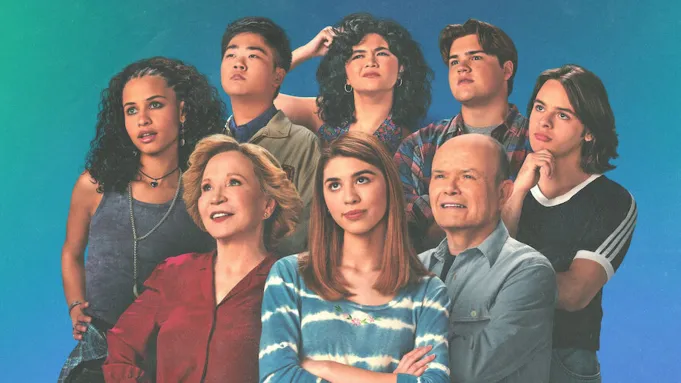
Last week, That ’90s Show star Kurtwood Smith posted to social media that Netflix would not be picking up a third season of his series. The idea is to shop it around to other outlets, but that almost never works. And, even when it does, it really doesn’t (Community being “saved” by Yahoo! Screen comes to mind). This is an example of the changing marketplace, involving television production, as well as current viewing habits. At the end of the day, Netflix didn’t feel the Math was Mathing. It’s also an indictment of a bigger problem with television: Streaming was propped up as the false savior for an industry that had an expiration date that was actually further off into the future than reported. Yes, “television” could probably be thought of as a “dying medium”, but streaming came along and sped up that death rather than stave it off.
It wasn’t like this in the beginning, as streamers were seen as possible outlets for shows that couldn’t bring in “major network ratings”. At the time, there was still an understanding that there was an audience out there, which may not be a Friends-level audience, but might be a Girlfriends-level audience (Ya see what I’m getting at there? Sayin’ it without sayin’ it?), and in scooped a streamer to the rescue, as they needed content to attract subscribers. Over time, however, these streamers didn’t want to be seen as snatching up the underperforming scraps of other networks, and decided to make their own shows. I mean, why pick up ABC’s 4th attempt to recreate Lost when you could just throw some cash at a women’s prison dramedy? It’s women, IN PRISON! There’s a chance they might kiss! And they could do that on streaming! Eventually, though, the streaming originals got too expensive, as it costs money to have Maya Rudolph voice a sex demon, or to show Kevin Spacey doing bad things to people (Hey, they could have just filmed that as a reality show!). So, streaming started picking up concepts that weren’t really great for them, but the thinking was, “Well, we need content, so let’s give it a shot.” And, like clockwork, these things were routinely canceled before their third season. Just like That ’90s Show. Well, my argument is that this was a series that was never even designed to be a successful streaming show, and that true success was only possible through first-run syndication – possibly as part of the short-lived 10/90 deal.
Let’s back up a bit here: First-run syndication differs from off-network syndication, in that the former is when a show is designed to run on what we used to think of as “UHF channels”, and not on one of the Big Four (NBC/ABC/CBS/Fox), while the latter is when shows from the Big Four aired on UHF channels at a later date. Back in 1986, Star Trek: The Next Generation was in first-run syndication, while Who’s The Boss?, “Five Nights a Week!”, was in off-network syndication (To make it even more complicated, the Five Nights a Week model is known as “strip syndication”). Those channels tended to be independently owned and, needing content to fill timeslots, they purchased syndication rights for a certain number of airings. Like, “We will air the 7 seasons of this show, 3 times each, for 5 years.” It doesn’t matter when they air it, or even how often (as long as they don’t go over the per-episode airing limit), during that 5-year cycle. After that time, they can either renew the rights, or replace it with a more recent, more popular show. Meanwhile, the trade-off is that the channel gets to keep the ad money generated from commercials aired during the show. Some shows became mainstays, pretty much never leaving syndication (M*A*S*H and Seinfeld), while others pretty much disappear after that first cycle (30 Rock).
It should be pointed out that TV worked differently back then, as actors ain’t working as hard now as they used to. We’re talking 5-7 seasons of 22-episodes, while today’s shows are 4-6 seasons, of anywhere from 8-13 episodes. ABC thinks they’re throwing you a bone if you get 18 episodes of Abbott Elementary. So, a first-run syndicated show did 26 episodes a season, so that each episode could air twice during a calendar year, while off network shows were seen to be “eligible” for syndication once they hit 100 episodes. That was the magic number, so they would enter the off network race around season 5, once they were established hits and had enough inventory.
Before streamers started picking up failed network shows, syndication used be the one to save failed Big Four shows – especially if the show was canceled after its second or third season. The thinking was that the show was basically “on the doorstep” on having the inventory for a successful syndication run (i.e. high potential for generated ad revenue). So, studios would produce another season or two, selling those directly to an independent channel. That channel would also get the prior seasons that had been created for the Big Four network. They’re getting a show that might not have been a hit for NBC, but is just fine for KTRY in Des Moines, Sundays at 3 PM. So, for the investment of two seasons of Punky Brewster, that channel would end up with four seasons (which include the prior two from NBC) to fill their schedule. Plus – and probably most importantly – it keeps the cast and crew working. Mama’s Family and Charles In Charge are two examples of popular shows that gained long, fruitful lives from the Big Four to first-run syndication transition.
Another way TV changed, though, is that not every episode of that 22-episode order was good. Sometimes, they didn’t even matter. The trick, though, is that most of those shows were not telling an overarching narrative, so it didn’t matter. The beauty of syndication is that the episodes can seemingly be aired in any order, at any time of day. That’s why some shows make more sense than others. If you go way back, the only way you might be able to tell which season you were watching was if a character’s hairstyle changed, or if there were subtle updates to the living room set. With the exception of the swap of Bud & Sonya with Bubba, I CHALLENGE you to watch an episode of Mama’s Family and tell me what season you’re watching. Even more recently, if you watched Two and a Half Men, you might notice how old Angus T. Jones is onscreen, but the only tonal difference is if you ask yourself “Was this before or after Charlie Sheen went crazy?” There was nothing worse than catching a show at 2 AM that ended with “To Be Continued…” You mean I gotta have insomnia tomorrow night, too?!
TV’s different now. I get it. You can’t do 22 episodes on whether or not The Bear is gonna open his restaurant on time, or whatever the Hell that show is about. Not every show needs to be a “thinking show”, though. Another advantage of syndication is that old sitcoms didn’t require much thought. You didn’t need to know continuity. I think we still need that from some of our entertainment. Shows that you can just put on in the background. In this chase for “prestige TV” – ya know, the kind that wins awards, and the tech bros talk about while golfing – we’ve left behind the guilty pleasure show. We’ve also tried to turn guilty pleasure shows into prestige TV. You can’t turn a hoe into a housewife, and this is just putting lipstick on a pig. I don’t know who needs to hear this, but That ’70s Show was not a complicated affair. It wasn’t a Thinking Man’s Show. It’s about a bunch of teens, getting into teen shit, in the 70s. That’s the elevator pitch. The most clever thing that show ever did was its depiction of getting high, with the moving walls and junk, and even that got old by season 7. Yes, we live in an age of “legacy revivals”, like Peacock’s Saved By The Bell and ABC’s The Conners, but only one of those two was a success. It’s not always a “sure thing”, and it was an odd choice for Netflix to pick That ’90s Show as their attempt at the trope. That show was not designed for streaming, but it was designed for syndication.
Just before streaming plunged its sword into the chest of the syndication model, a company called Debmar-Mercury came up with an intriguing concept called the “10-90 Deal”. Here’s how it worked: Debmar-Mercury developed a show around a known star (no longer A-list, but still has recognition and a fan base), and 10 episodes were sold to a “lesser” cable network, like TBS or, at the time, FX. If the episodes did well, it triggered a clause in the contract where an additional 90 episodes would then go into production. The idea was that the show was going into “instant syndication”, as they would have the 100 episodes needed to sell to off network stations, while also providing content for the cable network. It was mutually beneficial, as the cable networks needed original, low cost programming, while Debmar-Mercury needed “creative financing” to get their projects off the ground. And it held a lot of promise because it was similar to how Tyler Perry got his series House of Payne off the ground. There was a burst of activity, where several shows were announced and rushed into production:
- Partners (FX), starring Kelsey Grammer and Martin Lawrence as partners in a small law firm
- Saint George (FX), starring George Lopez as the same character he plays in all of his other sitcoms
- Anger Management (FX), starring Charlie Sheen, post Tiger Blood, and loosely adapts the Adam Sandler/Jack Nicholson film
- Are We There Yet? (TBS), starring Terry Crews in the Ice Cube role from the Are We There Yet? films
There were others in development, such as a series starring Drew Carey, but I’m pretty sure you’ve only heard of two of the ones I listed: Anger Management and possibly Are We There Yet? This is because those were the only non-Tyler Perry success stories from the 10-90 model. Anger Management pointed out a problem with model: If the ratings started to decline in the middle of the run, the channel was already on the hook for whatever remained of the 90-episode order. So, FX ended up burying the episodes at weird times, as they knew the show was pretty much dead in the water, but the episodes had already been paid for. Plus, FX didn’t feel the series fit the brand image that the network was trying to cultivate. RIP, 10-90 Deal.
But it doesn’t have to be over. A show like That ’90s Show would be perfect for this model. While it doesn’t have established stars, it does have established legacy characters, in Red and Kitty Forman. The first 10 episodes would be the “setting the table” run, as it catches folks up to what’s been going on in Point Place since the first show ended. And, really, that’s where you spend your money. That’s where you bring back your Fez and your Kelso (mainly because they’ve probably got some sort of ownership stake in the show’s success), just as a “passing of the torch”. We are to *never* see Donna, Eric, or Hyde. Sure, they can be mentioned, and you might even hint at an appearance down the road, but you’ll never show them because A) they’d cost too much and B) you want to keep the audience on the hook for a potential appearance at some point. Keep in mind: 100 episodes are being ordered AT ONCE, and you’ve got to ensure you’ve got an audience for those 100 episodes, while ensuring the budget lasts the whole order.

When I look to channels that could benefit from this arrangement, my eyes are drawn to Freeform. Now, up to this point, we’ve been discussing linear broadcast channels, but off network syndication has also been keeping cable afloat in the lean years. I mean, Comedy Central just picked up Family Guy – a show that can be seen on about 3 different cable channels daily, at roughly any time of day. This is a Hail Mary play for a struggling brand. Freeform is in a similar boat. What began as The Family Channel, then became Fox Family Channel, then ABC Family, and now Freeform, it has a rep as the “angsty teen drama channel that you pay for”. It’s pre-2023 The CW, with higher production values? One thing I’ve noticed in recent years, though, is that there’s no humor on that channel. Sure, they air off network broadcasts of The Simpsons after their contractually mandated nightly reairing of that day’s 700 Club, but that doesn’t really count. Yes, grown-ish just ended a 6-season run over there, but it was never funny. It just featured characters spun off from an established ABC sitcom. They need to balance to drama with some laughs, and seeing as how That ’90s Show is still tackling teen issues, but from a comedic perspective, I think it’d be a good risk for Disney to take.
This is how I spend my free time. I get a minute to daydream, and this is what becomes of that time. I know this stuff will never happen, but it seems like it’d be worth it to try. I mean, it can’t be any worse than what will probably happen, which in this case would be That ’90s Show remaining canceled permanently. In his post, Smith said the show would be shopped around because “good grandparents would try hard to get these kids graduated from high school.” Ya know what else reminds me of “good grandparents”? A huge TV showing a bunch of mindless shows – shows that weren’t too heavy – and still give you a nostalgic “sense memory” when you run across them today. That was the power of syndication, and it’s a lost artform in today’s entertainment model. But it doesn’t have to be that way…



